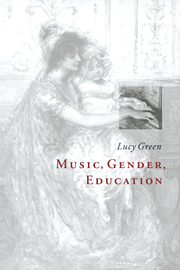Book contents
- Frontmatter
- Contents
- Acknowledgments
- 1 Introduction
- PART I MUSICAL MEANING AND WOMEN'S MUSICAL PRACTICE
- 2 Affirming femininity: women singing, women enabling
- 3 From affirmation to interruption: women playing instruments
- 4 Threatening femininity: women composing/improvising
- 5 Towards a model of gendered musical meaning and experience
- PART II GENDERED MUSICAL MEANING IN CONTEMPORARY EDUCATION
- Bibliography
- Index
4 - Threatening femininity: women composing/improvising
Published online by Cambridge University Press: 20 November 2009
- Frontmatter
- Contents
- Acknowledgments
- 1 Introduction
- PART I MUSICAL MEANING AND WOMEN'S MUSICAL PRACTICE
- 2 Affirming femininity: women singing, women enabling
- 3 From affirmation to interruption: women playing instruments
- 4 Threatening femininity: women composing/improvising
- 5 Towards a model of gendered musical meaning and experience
- PART II GENDERED MUSICAL MEANING IN CONTEMPORARY EDUCATION
- Bibliography
- Index
Summary
THE GENDERING OF COMPOSITION
The activity of musical composition is qualitatively different from that of performance, but this difference expresses itself to varying degrees. Some kinds of compositional activity, for example sitting in a silent room composing a piece of music in the imagination whilst consigning it to manuscript paper, are extremely different from performance. Others, such as spontaneously improvising a melody in front of an audience, are almost indistinguishable. In my use of the term ‘composer’ in this chapter, the constant quality of the composer's activity to which I will be referring is that of constructing music by choosing elements from a selection of pitches, durations, dynamics, timbres and textures. In general this will include improvisation as well as other non-notated activities such as the demonstration of a phrase to another instrumentalist, but at times I will make explicit reference to improvisation and other practices as distinct types of composition.
Different types of compositional practice affect not only inherent but also delineated musical meaning. For example, the production of classical music of the era of Haydn, Mozart and Beethoven used to involve both improvisation and notated composition. However, the delineations of this music today tend to override the improvisation, which has of course been lost to posterity, and to suggest that the music's inherent meanings rely entirely upon the score. The composer within such as style and viewed from such a perspective is constructed as working alone, possibly intermittently at an instrument, definitely on paper, away from any performance of the whole composition in real time, creating in the mind a complex and multi-faceted musical artefact which can only be conceived and subsequently communicated to others thanks to its notation.
- Type
- Chapter
- Information
- Music, Gender, Education , pp. 82 - 115Publisher: Cambridge University PressPrint publication year: 1997



